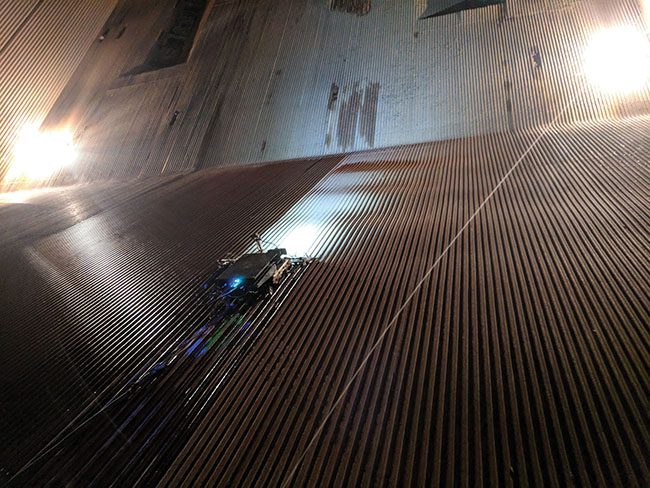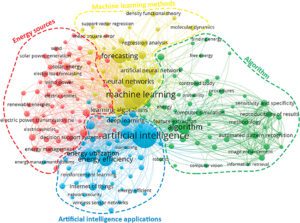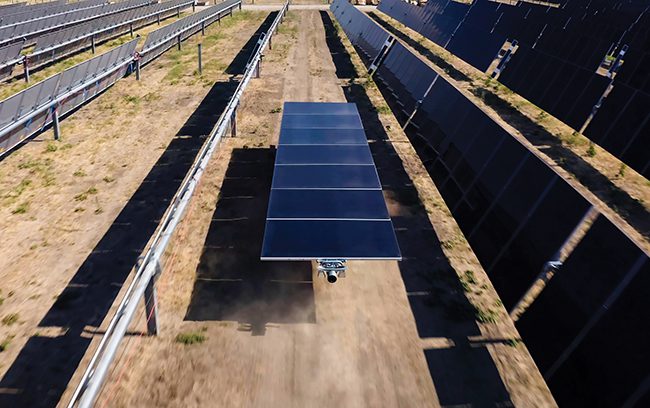Dynamic Innovation in Power Sector Digitalization
Credit to Author: Sonal Patel| Date: Thu, 01 Jun 2023 04:32:26 +0000

The power industry’s rapid adoption of digitalization is a striking example of its dynamic innovation—the continuous development and introduction of new ideas, products, or processes to meet shifting market demands. Here, POWER examines how some complex digital concepts, which, though frequently communicated under “buzzwords,” are making an actionable impact in the power space, from generation to consumer.
Digitalization—the holistic process involving the transforming of business models and operation into a more connected, data-driven, versatile, and efficient environment—has become an established power sector lever as the energy transition unfolds. So far, that process has involved a wide variety of complex and rapidly evolving digital technologies that involve an array of approaches.
Keeping up with the latest developments is not easy, given that the power sector itself is so complex—with a wide range of stakeholders, from power generators, transmission and distribution companies, regulators, and a broad array of consumers. Here, POWER pins down some underlying digital technologies and emerging concepts, and illustrates how power stakeholders are using them (or intend to use them).
A Flourishing Landscape for Artificial Intelligence
At least two years ago, power professionals were largely convinced artificial intelligence (AI)—the capability of machines to rapidly learn from large data sets, solve problems, and continuously adapt to new data without human intervention—was hype. But owing to advances in computing systems, AI and its subset, machine learning, have become increasingly important, with dominant applications in efficiency and utilization, forecasting, algorithm and pattern recognitions for learning systems, and management and transportation of energy sources (see sidebar). AI’s potential is also thriving for energy storage, uncertainty analysis, wastewater treatment, emission control, biofuel production, energy supply chain management, renewable energy, risk assessment, and demand response.
 |
1. A map created by researchers from the University of Tehran attempts to illustrate connections between artificial intelligence (AI) and machine learning (ML) in the energy field. The color blue covers AI applications in energy efficiency and utilization; yellow covers ML and its related methods for forecasting; green covers algorithms and pattern recognition for learning systems; and red covers energy sources and consumers. Source: Energy Strategy Reviews, January 2023 |
The use cases are seemingly endless (Figure 1). In January 2023, an AI-enabled power marketer unveiled Gridmatic Retail to streamline the purchase of renewable energy while offering predictability and automation to business and industrial clients. Another company, Imperium Predictive Analytics, uses AI to help consumers make more informed decisions around procurement strategies as they hedge portfolios using an algorithm that predicts short-, medium-, and long-term horizons.
Imperium founder Lucas Grimes said the service’s key value is to provide market transparency through a simplified process, allowing more stakeholders to assess and make decisions based on actionable data. However, Grimes noted the biggest challenges with AI, particularly in the forecasting space, continue to revolve around “data acquisition and data validation.” Data accuracy is another concern, he noted.
Power Industry Use Cases for ChatGPT-Like ModelsOpenAI’s release in November 2022 of ChatGPT, a commercially available chatbot that is based on an artificial intelligence (AI) large language model (LLM), ushered in widespread recognition that generative AI could deliver a step change in the human-to-data interface. And while generative AI is already disrupting many industries, it could hold substantial potential for the power sector, including to help automate, develop, communicate, and analyze data, several experts have suggested. As Geir Engdahl, chief technology officer at Cognite, explained to POWER, “What’s going to be very valuable is the combination of deep domain knowledge and data, and a system that is able to carry out the task. So, it has all the piping in place, data operations, if you will, where data is flowing from your actual power plant operations into the system continuously, and we have the ability to carry out tasks that have value within the system, such as creating inspection orders, or do root cause analysis with all of the data available to you,” he said. “I think the combination of this ‘data ops’ and ChatGPT and similar large language models, that is going to really change the way that knowledge workers in these industries work.” The biggest gains from custom-designed generative AI programs could be applied to all phases of asset performance management, in tasks such as identifying equipment for which automated monitoring has triggered alarms, Engdahl suggested. “It’s able to kind of synthesize all this industrial knowledge and make really clever suggestions,” he noted. “Of course, the human will be in the loop and make the final call as to what to actually do.” In addition, generative AI models could provide references to documents, or assist in onboarding data into a knowledge graph. “What that means is as you are ingesting, for instance, unstructured data, which could be documents or drawings, you could derive more context from the data.” The model could, for example, identify the specific type of document, and it could allow workers, through detailed “human language,” to quickly query and get specific details about a document. Engdahl, however, cautioned that the model has shortcomings and flaws including “hallucinations,” lying by omission, data security, and intellectual property protection, he said. |
Getting on the Cloud
Cloud computing, a means by which large amounts of data can be stored and processed for efficient data analysis and real-time decision-making, also appears to be gaining steam in the power space. Amazon Web Services (AWS) has recently signed lucrative deals with several utilities to provide cloud technologies and data-driven solutions based on advanced analytics. Duke Energy, for example, in November 2022 began a “multiyear strategic collaboration” to build new smart grid software and services on AWS and expand its Intelligent Grid Services—a suite of custom-built applications that help the utility anticipate future energy demand and identify where and how to update the power grid. The utility also agreed to migrate its information technology and grid analytics workloads to AWS.
“Our digital evolution is foundational to our clean energy transition,” said Bonnie Titone, senior vice president and chief information officer at Duke Energy. “For example, to accurately simulate future energy needs and plan investments for the grid, we need to run hundreds of millions of power flow calculations—a process that would take weeks using traditional IT [information technology] hardware. By using cloud technologies that AWS is developing for Duke Energy, we aim to run those same simulations in 15 minutes or less.”
Robotic Advancements
As a big boost to power plant operations and maintenance, advancements in robotics are meanwhile poised to reshape difficult operations and maintenance tasks. Autonomous robotic inspection is already being used in a fleet of diverse robots that are suited to handle difficult or dangerous environments. Consumers Energy and National Grid are separately using Boston Dynamics’ Spot, the company’s iconic dog-like agile robot, to inspect assets at the company’s critical electrical substations, capturing thermal scans and gauge reading autonomously. Ontario Power Generation and Duke Energy are meanwhile using Spot for inspection missions at nuclear power plants. Spot has also been deployed at hydropower plants and mining areas, assessing areas that are hazardous due to risk of seismic activity, rock stability, or the presence of poisonous gases.
 |
2. Gecko’s TOKA 4 robot scales a boiler, collecting ultrasonic data to fuel an artificial intelligence–powered software platform. Courtesy: Gecko Robotics |
Pittsburgh-based Gecko Robotics has also seen a ramp-up in interest in its robots. Armed with multi-angle ultrasonic scans and visual cameras, its climbing TOKA series robots (Figure 2) can inspect tanks, boilers, scrubbers, piping, wall-thickness, and pitting. The business has grown especially pivotal given the power sector’s aging assets. “We’re in the business of taking companies from reactive maintenance with very linear or poor reliability to proactivity, but even beyond that,” Jake Loosararian, CEO and co-founder at Gecko Robotics, told POWER.
Gecko also offers AI-enabled data analysis collected from the multifaceted inspections enabled by robots, which has proven invaluable to some of its power plant customers. “We’ve collected and own data on tens of thousands of assets. We’re able to give insights using some of the advanced software into what we think will fulfill, predicting obviously from the data sets what some of the problems are, but also be able to ensure that there is prudent spend of capex [capital expenditure] to fix the problems, not just today but into the future, so that you can extend how often you are shutting down.”
Connected Devices and the Drawback
As defined by the National Institute of Standards and Technology (NIST), internet of things (IoT) comprises the interconnection of consumer-level digital devices (such as smart appliances and cellular devices). By contrast, industrial IoT (IIoT) covers the interconnection of digital devices, such as sensors, instruments, and machines in industrial, manufacturing, and business processes, for example, safety, performance tuning, access control, facilities control, security, and maintenance.
IIoT is also notable for its integration of information and communication technology to enhance operational technology (OT), which are “programmable systems or devices that interact with the physical environment.” OT systems, for example, include instrumentation and control (I&C) systems, supervisory control and data acquisition (SCADA) systems, and distributed control systems. While traditional OT typically interconnects via wired networks, IIoT devices can use a range of wireless technology for wide area coverage, including WiFi, cellular, satellite, Bluetooth, or radio frequency identification. NIST notes that rather than replacing traditional process control, IIoT devices are intended to enhance industrial processes through additional monitoring of various sensors and application of data analytics models.
Driven by advancements in technology and efforts to ramp up power component cost-savings, convenience, efficiency, reliability, and sustainability, IIoT devices are proliferating. As just one of hundreds of examples, a predictive maintenance team at NRG Energy, a competitive generating giant, recently added continuous wireless asset monitoring that would provide more frequent data and allow earlier detection of developing failures to better assess equipment condition at its power plants.
A frequently cited hurdle related to IIoT devices is that wireless networks can experience outages, and they can be expensive to deploy, especially if integrating with legacy infrastructure. A specific advancement on this front has notably been the integration of 5G, a wireless communication system. 5G, notably, has paved the way for wireless isochronous real-time motion control, sensor systems for monitoring critical processes, and augmented reality and virtual reality applications, noted 5G-ACIA, an alliance for connected industries and automation. The benefits of high-bandwidth, low-latency connectivity, meanwhile, include expanded maintenance applications, as well as for plant safety and security.
“Geo-fencing applications can be used for the security and safety of workers and the public. If a worker enters an area that should be avoided, their wearable sensor can trigger an alarm,” noted Dominique Verhulst, head of Global Energy Practice at Nokia. “These types of applications can also be used at remote plants, alerting central security teams to any unauthorized activity at a site. To further limit human activity in restricted sites where it could be too hazardous for a person to work, remote-controlled robots can be activated on the network to automate maintenance activities.”
However, cybersecurity risks affiliated with IIoT systems—particularly of commercial off-the-shelf devices that don’t include intrinsic security features—are also a pervading concern. According to Lior Frenkel, CEO of Israel-based Waterfall Security Solutions, emerging solutions are being implemented across many utilities to address cybersecurity risks related to IT/OT integration. Frenkel highlighted Waterfall’s Unidirectional Gateways, an “evolutionally alternative” to firewalls that can secure remote access as well as allow real-time industrial network monitoring.
“In cybersecurity, risks for OT networks, production networks, for control networks is new. As a market, it’s probably five years old,” he said. “The thing that changed five years ago is the move of the threat from terror-based, state-owned to ransomeware.”
Waterfall’s approach, which Frenkel said is deployed by major utilities like Southern Co., essentially seeks to remove firewalls usually connected between the control network and the outside world. Other emerging security technologies Frenkel said he is watching include intrusion detection technologies, which can remotely monitor the network. However, monitoring is also now available as a service, he noted.
Digital Tools Transforming the Larger Power System
Digital tools are reshaping several aspects of the larger power system, too. Along with machine learning that can predict the output of solar panels based on weather conditions, several technologies have emerged to facilitate virtual power plants—which combine distributed energy resources to provide grid services.
Digital technologies are also enabling the creation of microgrids, small-scale, self-contained energy systems that can operate independently on the larger grid, and hybrid power plants. In one unique example, the National Renewable Energy Laboratory (NREL) and the Idaho National Laboratory (INL) in January 2023 demonstrated that nuclear at INL and renewables at NREL could be virtually synchronized using ESnet-operated fiberoptic cabling and digital real-time simulators.
On the distribution front, utilities want to invest more in “downline devices that build knowledge into their modeling tools, as well as operational functionality to resolve common congestion power quality issues,” noted Sally Jacquemin, vice president and general manager of Power and Utilities with AspenTech’s Open Systems International (OSI) business unit. And on the transmission side, monitoring and controlling generation assets through dynamic stability analysis is growing more significant to assure stability in voltage and frequency throughout the grid with renewables, she said.
Digital technologies are also creating new energy trading platforms that enable more efficient and transparent trading of renewable energy credits and other energy commodities. Blockchain, which has been key to these efforts, is also proving useful for efforts to procure and supply carbon-free energy 24 hours a day, seven days per week (24/7 CFE).
For example, Cleartrace, a third-party vendor, has collaborated with JPMorgan Chase (JPM) in the UK since 2020 to monitor JPM’s energy usage using blockchain-based energy-tracking technology. The technology matches JPM’s electricity consumption digitally, in real-time, to renewable generation as part of a 24/7 power purchase agreement. Cleartrace’s platform is also used by NextEra, Iron Mountain, Brookfield Properties, and Brookfield Renewable.
 |
3. Terafab’s digitally fortified construction model promises to speed up the construction of solar power plants, reduce construction costs, and eliminate the physical safety risk of construction workers needing to lift heavy solar panels and steel structures (often in harsh weather conditions) by utilizing automation on a climate-controlled assembly line. This rendering shows Terabase Terafab at an “automated, digital field factory.” Courtesy: Terafab |
Finally, digital advancements are also boosting supply chains and transforming construction. In May, digital and automation solutions firm Terabase Energy announced the world’s first automated digital field factory for solar power plant construction. Slated to deploy in fall 2023, the comprehensive Terafab system (Figure 3) will combine a digital twin of a project site, advanced supply chain and inventory management systems, an onsite wireless digital command center, a field-deployed automated assembly line, and specialized installation rovers into a seamless 24/7 operation, the company told POWER.
—Sonal Patel is a POWER senior associate editor (@sonalcpatel, @POWERmagazine).
The post Dynamic Innovation in Power Sector Digitalization appeared first on POWER Magazine.